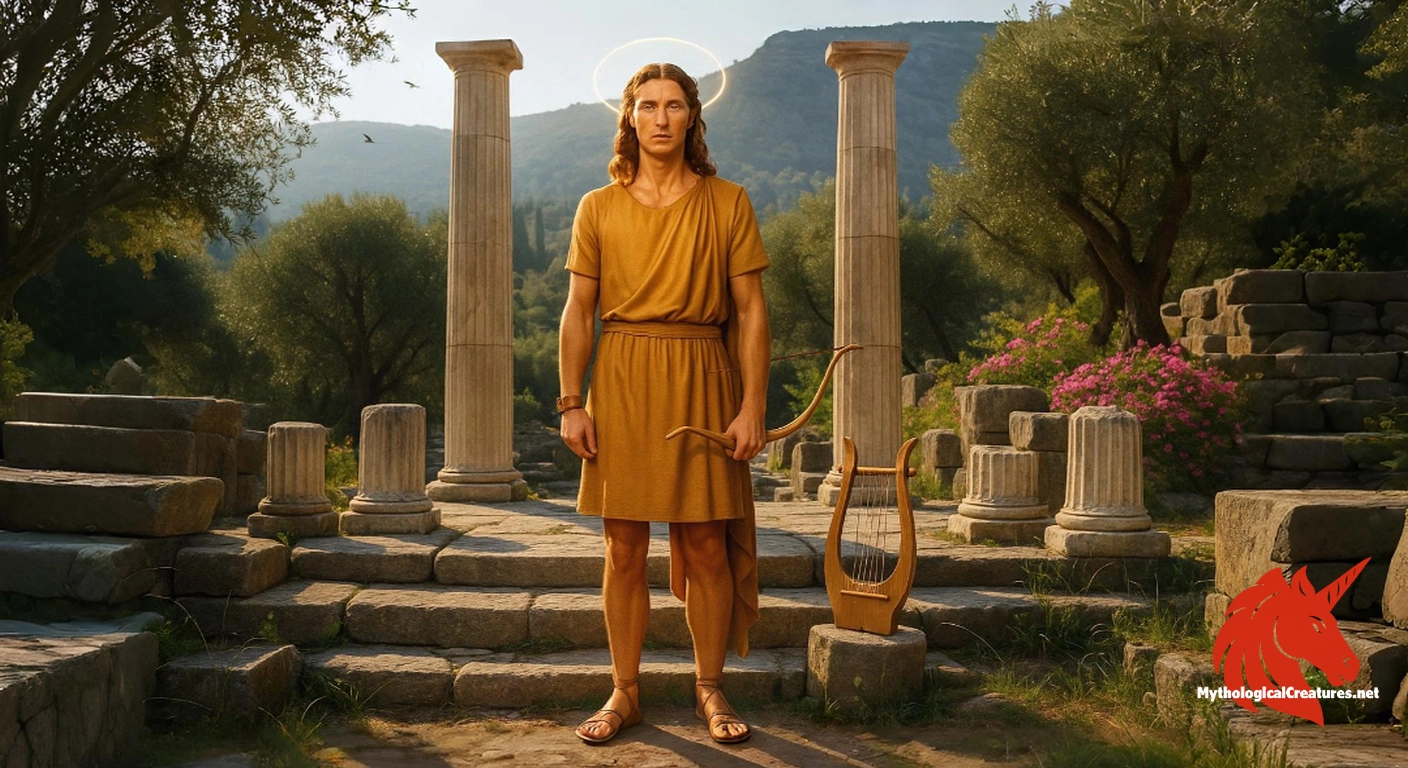Apollo: Apollo is a multifaceted Olympian god revered in ancient Greek and Roman mythology.

Apollo
Apollo - Apollo’s multifaceted domains and his dual ability to heal and bring plague highlight his profound influence on ancient art, law, and health.
Origins & First Encounters
Apollo stands as one of the most celebrated and intricate figures of ancient myth, embodying a rare blend of youthful beauty and multifaceted divinity. Born of Zeus and Leto with Artemis as his twin, he emerged from the earliest layers of Greek religious thinking to become a central figure in the Olympian pantheon. His mythic narrative, which dates back to the archaic era, intertwines the spheres of art, prophecy, healing, and warfare, thus reflecting a unique duality. The deity’s character bridges the gap between benevolence and severity, as he is equally known for bringing health and for wielding plague with his arrows. Throughout ancient Greece and beyond, his iconography came to symbolise not only the physical ideal but also the cultivated mind, inspiring both sculptors and poets alike. Early poetic hymns and ritualistic ceremonies laid the foundation for his enduring mythos, underscoring his significance in state and civic cults. His extensive worship in diverse regions illustrates how local communities adapted his qualities to address both communal needs and existential questions. The layered nature of his persona reveals a god who governs the balance between light and darkness, underlining his continual appeal in the human quest for meaning. His legacy as a patron of the arts and a beacon of divine beauty remains a cornerstone of classical mythology.
Source Texts & Tale Variants
The corpus of ancient literature offers a vibrant tapestry centred on Apollo, with his exploits vividly recounted in texts such as the Homeric Hymns and various poetic odes. His deeds and divine attributes are elaborated in mythographical works like those of Apollodorus, ensuring that his narrative was passed down through generations. The sanctuaries dedicated to him, especially at Delphi, provided a living archive where oracles and ritual practices became intertwined with sacred inscriptions and local legends. Numerous festival records and dedicatory epigrams celebrate his multifaceted character, thereby complementing the more formal literary sources. Tragic playwrights and later commentators expanded upon his myths, each adding layers of interpretation that highlight his dual nature as both nurturer and avenger. Variants of his narrative emerge from diverse geographical and cultural contexts, demonstrating how oral traditions and local customs enriched his lore. These multiple strands of evidence coalesce to depict a deity whose divine authority spanned the realms of the physical and the mystical. Through an intricate weave of poetry, ritual, and epigraphic records, Apollo’s myth remains both dynamic and adaptable. The broad array of sources serves as a testament to his enduring place in the collective memory of the ancient world.
Form & Powers
Depictions of Apollo consistently highlight his embodiment of idealised physical perfection, rendered as a youthful, beardless figure with a harmonious blend of strength and grace. He is typically presented with radiant, flowing hair that symbolises eternal youth and divine splendour, a trait that distinguishes him from his contemporaries. Artists often capture his penetrating eyes, which seem to reflect both an inner wisdom and a visionary quality. His customary attributes include a finely crafted bow and a quiver of shimmering arrows, each instrument embodying his capacity to both heal and inflict harm. The presence of a laurel wreath in many portrayals reinforces his connection to victory, music, and poetic inspiration. His attire, often of draped, elegant fabric, underlines the classical proportions and balance that are hallmarks of his iconography. In various sculptures and vase paintings, the luminosity that seems to emanate from his form underscores a link with the sun and the idea of enlightenment. Detailed artistry emphasises his muscular yet refined build, setting a benchmark for classical aesthetics. Such physical representations have profoundly influenced the artistic depiction of beauty across centuries, resonating as the quintessential image of divine perfection.
Regional Faces
Across the ancient Mediterranean, Apollo was revered in varying forms that reflected the distinct cultural and religious priorities of each region. In Delphi, he was primarily honoured as the god of prophecy and purification, with the Oracle serving as the heart of his sacred cult. In contrast, within the Etruscan tradition, he appeared as Apulu, a variant whose attributes were subtly adjusted to suit local rites and iconographic conventions. Several Greek city-states emphasised his role as a patron of music and healing, while others celebrated him as a protector of young men and a lawgiver. Rural communities often embraced his pastoral aspect, honouring him as the guardian of herds and crops against misfortune and disease. During the Hellenistic era, his identity underwent further transformation, at times merging with solar deities such as Helios to reflect an intensified connection with the light of day. The diversity in his regional worship is further illustrated by the varying ceremonies, symbols, and narratives that each locale bespoke. Such flexible adaptations underscore how his myth was continually reshaped to address local environmental, social, and spiritual needs. Ultimately, the regional variations in his worship testify to the dynamic nature of myth-making and the permeability of divine identity.
Cultural Parallels
Apollo’s character invites cross-cultural comparisons that highlight universal themes of beauty, wisdom, and the duality of creation and destruction. Observers have often paralleled him with the Roman deity Sol and even with sun deities from distant traditions, underscoring his celestial radiance and centrality in myth. Much like Egypt’s Ra, who embodies both the luminosity and the peril of the sun, Apollo encapsulates the power to both heal and harm. His patronage of the arts, as seen through his association with the Muses, resonates with other cultures that celebrate the divine conjugation of creativity and divine inspiration. The Norse deity Balder, revered for his beauty and the sorrow his loss engendered, shares several thematic elements with Apollo, especially in the context of idealised youth and tragic foresight. This comparative framework extends to the broader Indo-European mythological landscape, where figures of similar dual natures emerge in diverse narratives. The convergence of prophetic wisdom, musical artistry, and martial prowess in Apollo’s myth mirrors the multifaceted nature of divinity celebrated across continents. In many respects, his narrative forms a bridge that connects disparate mythic traditions, revealing a common human appreciation for the interplay of light, art, and fate. Such cultural parallels offer profound insights into how societies embody and transmit their ideals about beauty, power, and the cosmic order.
Legacy & Modern Evolution
Across the flow of time, Apollo’s myth has evolved to encapsulate a range of meanings, from a formidable divine arbiter to an enduring emblem of artistic and intellectual pursuit. His representation underwent significant reimagining during the Renaissance, when his idealised form and thematic resonance became central to the works of painters and sculptors. In modern culture, he continues to inspire through literature, music, and visual arts, serving as a symbol of balanced duality where beauty is intertwined with power. Contemporary reinterpretations frequently highlight his role as a healer and a promoter of enlightenment, bridging the gap between ancient practice and modern spiritual thought. His narrative has been reinvented to resonate with broader themes such as rationality, creativity, and the perpetual quest for truth. In academic and popular discourse alike, Apollo remains a figure whose myth invites continual reinterpretation in line with evolving cultural and philosophical values. The dynamic evolution of his worship reflects a shift from strict ritualistic observance to a more symbolic and metaphorical embrace of his legacy. As modern media explore his myth deeper, his dual capacities to inspire hope and incite caution continue to be powerful allegories in contemporary storytelling. Ultimately, Apollo’s enduring presence illustrates the timeless dialogue between tradition and innovation, ensuring his myth remains a living part of cultural heritage.
Interesting Fact
Despite his reputation as a bringer of healing and light, Apollo is equally known for unleashing plagues with his arrows, illustrating the ancient belief in the dual and unpredictable nature of divine power.
Quick Creature Info
Origin:
Associations:
Our Mythic Legendary Rating:

Also Sometimes Known As:
Habitat:
Supernatural Powers:
Physical Attributes:
Abilities:
Behavior:
Lore:
References
Discover Another Mythical Legend You May Not Have Heard Of?
Uncover the mysteries of ancient folklore and expand your knowledge of legendary beings from cultures around the world.
Dare to Meet the Grindylow....
Mythical Disclaimer: The images and data on this site are derived from various historical and literary sources, but we have found that many myths often have multiple versions and interpretations across references, sometimes contradictory. As a result, these creature depictions are artistic interpretations—imaginative blends of folklore, legend, and a dash of AI guesswork. Because creature descriptions vary widely, our illustrations and accompanying information represent our best effort to honor mythology while bridging creative gaps. Enjoy these interpretations—just remember, we've done our best to respect the stories and validate available data, but in the realm of mythology, details often shift, imagination leads the way, and nothing is ever set in stone!
Curated by the Mythological Creatures Team (rev. May 2025)
